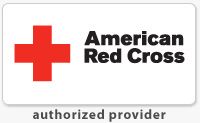Which class should I choose to take?
There are numerous American Red Cross and American Heart Association classes from which to choose. How do you decide which is the best one for you or your group? We hope that this page will help.
If you are looking for training and certification specifically for your employment, volunteer work or school, it’s best to ask them which class they require for you. If they don’t know the answer to that question, you can always refer them to this page. If, on the other hand, you’re looking to get trained for your own personal enrichment, then it’s purely up to you which class you take, as there are no prerequisites for any of them (except for review classes).
Below, you will find descriptions of all of the classes that we offer. Please read the descriptions thoroughly and make your decision carefully, as it is the student’s responsibility to make the correct determination before registering for a class. If still unclear about what class to choose after reading this page, please contact us and we’ll do our best to help you decide.
CPR/AED certification for the general public
Adult & Child CPR/AED, Pediatric CPR/AED (or any combination)
In these classes, you will learn to how to safely check for signs of life, how to perform one-rescuer CPR, how to operate an automated external defibrillator (AED), how to use personal protective equipment (PPE, such as breathing barriers and gloves), and how to assist choking victims. You will also learn about legal considerations regarding providing care.
American Red Cross certification, awarded upon successful completion of this class, is valid for two years (however, it is still highly recommended that you take it more often than that, to be well prepared for an emergency).
Note: “Adult CPR/AED” teaches how to provide care for someone ages 12 and above. “Pediatric CPR/AED” teaches a combination of both Child and Infant CPR/AED skills.
–––––––––––––––––––––––––––––––––––––––
First Aid certification for the general public
First Aid (standard and pediatric)
In this course, you will learn to care for wounds (bleeding, burns, concussions and spinal injuries) and for sudden illnesses (strokes, seizures, poisonings, diabetic reactions and allergic reactions), as well as how to deal with heat- and cold-related emergencies. You will practice bandaging a wound and applying a sling.
American Red Cross certification, awarded upon successful completion of this class, is valid for two years (however, it is still highly recommended that you take it more often than that, to be well prepared for an emergency).
–––––––––––––––––––––––––––––––––––––––
Combination CPR/AED and First Aid certification for the general public
First Aid plus Adult CPR/AED, Child CPR/AED, Infant CPR/AED
In this combination First Aid/CPR/AED class, you will meet the State of Colorado requirements set forth for child care workers. See above for descriptions of CPR/AED and First Aid for the general public.
–––––––––––––––––––––––––––––––––––––––
AED certification for the general public
AED Training
Without rapid defibrillation, a victim’s chance of survival decreases by about 10 percent per minute. Using safe training devices, you will learn how to properly operate an automated external defibrillator (AED).
AED training classes are available for groups, practically anywhere in the Twin Cities (Minneapolis-St. Paul) area, and are held in the convenience of your workplace. American Red Cross certification, valid for two years, is available upon request.
Note: This class requires that you are currently certified in American Red Cross or American Heart Association CPR.
–––––––––––––––––––––––––––––––––––––––
BLS CPR/AED certification for health & safety pros
CPR/AED for Professional Rescuers and Health Care Providers
As a health and safety professional (nurse, paramedic, EMT, first responder, lifeguard, etc.), it’s important to be ready to handle unexpected medical emergencies.
In this class, you will learn all of the skills of one-rescuer Adult and Pediatric CPR classes (also known as Adult, Child and Infant CPR classes). Plus you will learn how to provide two-rescuer CPR, how to operate an automated external defibrillator (AED), how to use a bag-valve-mask (BVM), how to use personal protective equipment (PPE, such as breathing barriers and gloves), and how to assist choking victims. You will also learn about legal considerations regarding providing care.
American Heart Association certification, awarded upon successful completion of this class, is valid for two years (however, it is still highly recommended that you take it more often than that, to be well prepared for an emergency).
Note: There are no prerequisites for taking this class and you don’t even need to be a health and safety professional. However, to take a CPR renewal class, you must qualify. To quality, you must have successfully completed American Heart Association “BLS CPR/AED for Professional Rescuers and Health Care Providers,” American Red Cross “CPR/AED for Lifeguards,” or American Heart Association ”BLS for Healthcare Providers,” within the past two years: There are no exceptions to this rule. If you don’t qualify, please sign up for an initial certification class instead.
Bloodborne Pathogens certification for professionals and the general public
Preventing Disease Transmission
This class teaches you how diseases are spread and what you need to know and do to protect yourself against disease transmission.
American Red Cross certification, valid for one year, is available upon request (upon successful completion of this class).
Note: This class meets OSHA standards on bloodborne pathogens for anyone with potential for contacting blood and other potentially infectious materials while at work. It also meets the Colorado Child Care worker reuqirements.
